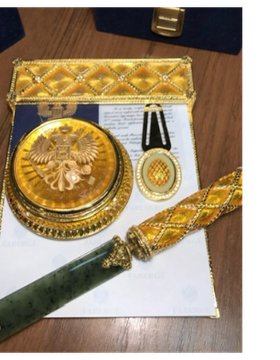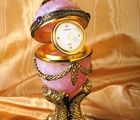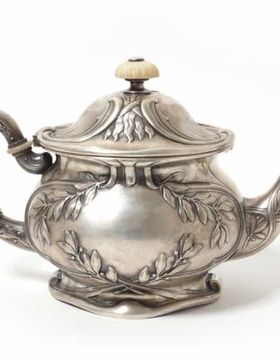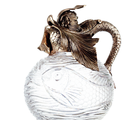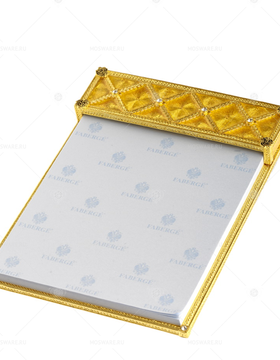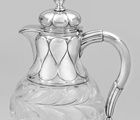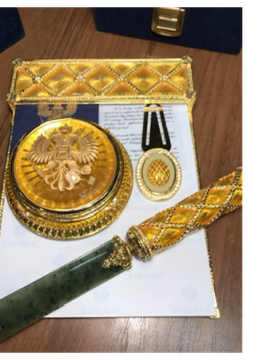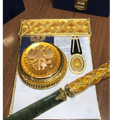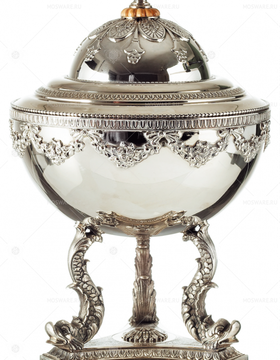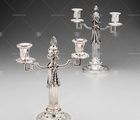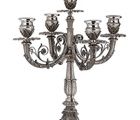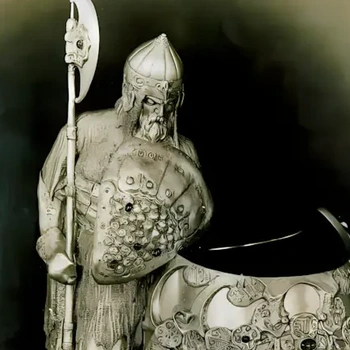
Последние десятилетия XX века стали временем удивительного возвращения забытых шедевров русского ювелира Карла Фаберже (1842-1920), которые, казалось, навсегда исчезли из поля зрения. Эти открытия порой происходили в самых неожиданных местах и обстоятельствах.
Так, в 1990 году, во время реновации старого дома на Солянке в Москве, рабочие наткнулись на невероятный клад — изумительные ювелирные изделия, золотом и бриллиантами. Как стало известно, этот сокровищница была спрятана после революции В.С. Аверкиевым, одним из управляющих знаменитым Товариществом «Карл Фаберже». В итоге музею Кремля удалось заполучить тринадцать уникальных изделий, созданных в заключительный этап работы этого легендарного предприятия, и эти шедевры неоднократно выставлялись на показ, как в России, так и за ее пределами.
Всего через четыре года Кремлевский музей пополнил свои коллекции еще одним драгоценным экземпляром — великолепным цветком, стилизованным под одуванчик. Этот деликатный цветок из золотого стебелька с нефритовыми листьями был помещён в хрустальный стаканчик, который выглядел так, словно наполнен водой. На тончайших серебряных тычинках располагался натуральный цветочный пух, а среди него блистали мелкие алмазы, словно утренняя роса. «Одуванчик», сохранённый в оригинальном футляре Фаберже, долгое время дожидался своего момента на антресолях скромной квартиры на окраине столицы, пока его владельца не решила передать эту семейную реликвию в руки национального художественного наследия России.
Начало XXI века ознаменовалось новым открытием, значимость которого нельзя переоценить. В 2001 году в фондах Минералогического музея имени А.Е. Ферсмана были идентифицированы фрагменты из белого кварца, синего хрусталя и драгоценных алмазов как элементы незавершенного императорского пасхального яйца, задуманный в 1917 году. Эти детали, переданные в музей в 1925 году сыном Фаберже, Агафоном Карловичем, стали свидетельством о его встречах с академиком Ферсманом. Яйцо, начатое в годы войны, но оставшееся недоделанным, получилось последним аккордом в изысканной симфонии пасхальных шедевров Фаберже — своеобразной драгоценной летописи исчезнувшей Империи.
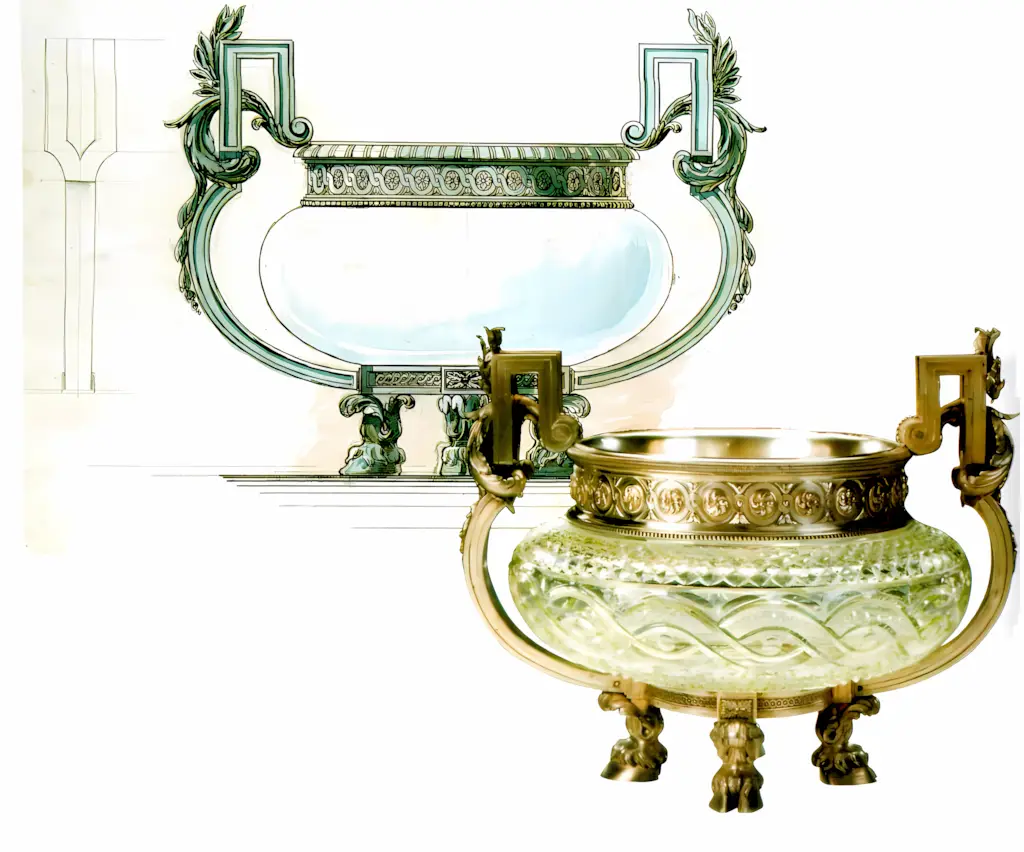
В последние десятилетия творчество мастеров фирмы Карла Фаберже вновь стало вызываться к жизни благодаря неожиданным находкам, связанным с проектами и эскизами знаменитого ювелирного дома, обнаруженными как на Западе, так и в России. Так, первый значимый шаг в этом направлении был сделан английским экспертом Кеннетом Сноуманом, который представил страницы из дизайнерских книг петербургской мастерской А. Хольмстрема, известной по главным образом своими ювелирными изделиями. Спустя несколько лет, благодаря поддержке известного антикварного дома «A La Vieille Russie», в Нью-Йорке состоялась выставка и была опубликована уникальная коллекция рисунков, созданных в ведущей мастерской Фаберже под руководством Генрика Вигстрема.
Вигстрем, финский мастер и ученик талантливого Михаила Герасима, стал автором великолепных ювелирных исполнений — от пасхальных яиц до камнерезных работ в драгоценных оправах, а также изысканной галантереи и так называемых «objets d’art», которые становились украшением российских императоров и светских знаменитостей Европы. После Октябрьской революции 1917 года Вигстрем вернулся на родину, и его забытое вдохновение было случайно найдено при уборке старого книжного шкафа, принадлежавшего его друзьям и соседям.
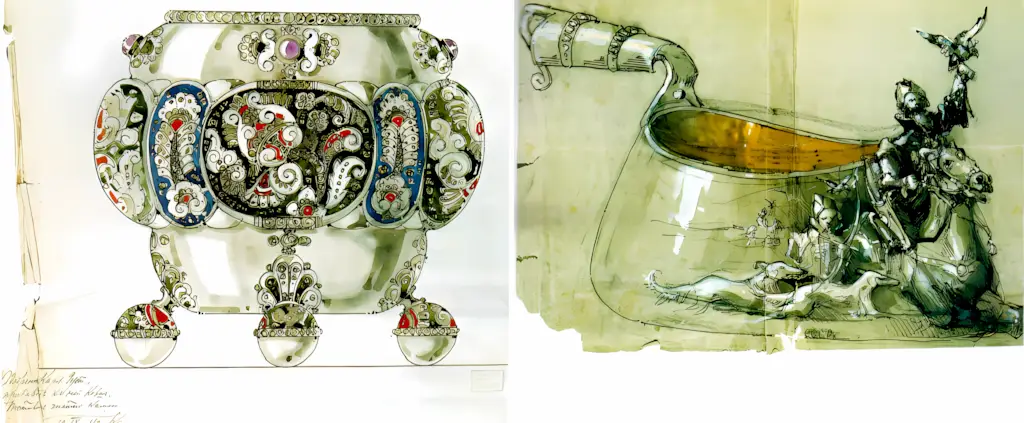
Не остались без внимания и находки в России. Более десяти лет назад потомки художника С.Н. Андрианова, который работал в московском отделении фирмы Фаберже начиная с 1909 года, передали в Музеи Московского Кремля множество акварельных эскизов и значительный альбом его работ. Это открытие стало настоящим событием в мире русского искусства. А в 2002 году в Москве произошла еще одна сенсация — был найден крупный комплекс дизайнерских разработок Фаберже, стоивший внимания тех, кто увлекается историей русского ювелирного мастерства предреволюционной эпохи. Редкая выставка, открывшаяся 26 ноября 2003 года в Школе акварели Сергея Андрияки, предоставила шанс ознакомиться с новыми рисунками, ныне находящимися в частных коллекциях, а также с несколькими произведениями Фаберже из фондов Минералогического музея имени А.Е. Ферсмана и антикварных галерей.
Этот замечательный проект был поддержан Комитетом по культуре Москвы и Русской гильдией антикваров.
«Утверждено Карлом Густавовичем…»
Вновь открывшаяся коллекция включает в себя 202 листа и в основном содержит проекты масштабных предметов из серебра — сервизов, призовых кубков, подарочных кувшинов, братин и чаш, а также оправ для хрустальных изделий, туалетных принадлежностей и офисных аксессуаров. Это отличие кардинально выделяет ее среди работ Хольмстрема, Вигстрема и Андрианова, сфокусировавшихся на ювелирных произведениях и более мелких предметах из золота, платины и драгоценных камней. Этот новый комплекс типологически близок к впечатляющему собранию рисунков фирмы Фаберже, пополнившему Государственный Эрмитаж в 1922 году через Музейный фонд. Тем не менее, как отмечают специалисты, большинство представленных эскизов — это «неосуществленные проекты» для объекта, на которые были сделаны заказы от Двора и кабинета Его Императорского Величества.
Особенность выставленных работ в Школе Андрияки заключается в том, что многие из них планировалось реализовать как в Санкт-Петербурге, так и в московском отделении Фаберже; изделия предназначались для разнообразной клиентской базы, включая зарубежных покупателей. На эскизе полихромной братины в русском стиле можно увидеть печать «Въ Англию», а на рисунке высокодекоративной стопы с рельефными фигурами богатырей и яркими кабошонами указана цена в английских фунтах — «Price about L 47». На шести листах присутствует печать «К. Фаберже. СПБ» с государственным гербом и датами с 1907 по 1912 годы. Также сохранились штампы «К. Фаберже Москва» на русском и французском языках на двух эскизах, и лишь на одном листе имеется печать «К. Фаберже» без указания филиала.
Эти находки подчеркивают огромный интерес к наследию Фаберже, которое вновь становится актуальным и востребованным как среди коллекционеров, так и среди ценителей искусства. Данная коллекция свидетельствует о богатом и разнообразном наследии, оставленном мастерами, и открывает новые горизонты для изучения их креативности и технического мастерства. Работы, изначально задуманные для выхода на международные рынки, подтверждают, что творения Фаберже были не только великолепными образцами русского ювелирного искусства, но и важными частями культурного моста между Россией и остальным миром.
К сожалению, на многих эскизах места, где должны были находиться печати мастерской, жестоко повреждены или отрезаны. Это отражает сложное отношение, сложившееся в Советском Союзе к наследию придворного ювелира русских монархов, а также к гербу Империи, который нередко сбивали с серебряной продукции. На одном листе можно уловить лишь бледные очертания двуглавого орла – символа, который имел право размещать лишь Поставщики Высочайшего Двора. Однако на нескольких эскизах все-таки сохранились инициал «КФ», вероятнее всего, являющийся подписью художественного руководителя фирмы. Читая надписи на этих старинных рисунках, словно становишься случайным свидетелем обсуждений проектов и планов, которые обсуждались в тот период.
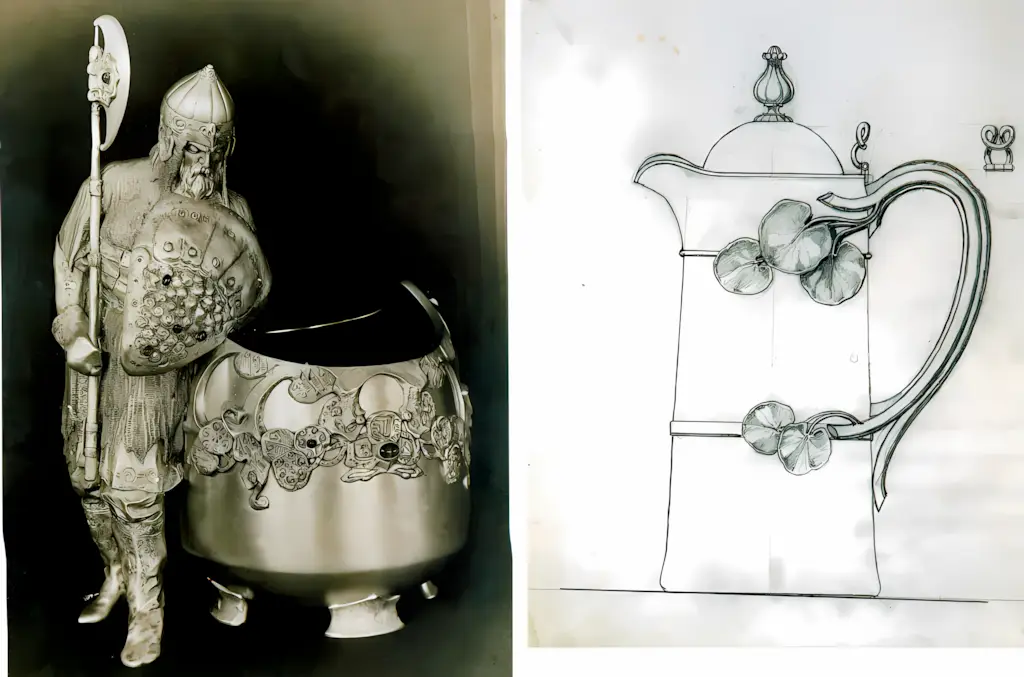
На графике великолепной лозы, отделанной эмалью, можно увидеть заметку о том, что она «одобрена Карлом Густавовичем», который предложил «добавить к ней ковш» и «вставить чистые камни». В другом варианте братины, изображённой с ковшом, позднее была сделана поправка, чтобы «сделать один вариант... без ковша». Иная бразильская чаша, первоначально задуманная из гладкого свинцового стекла в серебряной оправе, впоследствии была решено выполнить целиком из драгоценного металла. Комментарий на этом эскизе, подписанном «КФ», гласит: «Все в серебре, без хрусталя». На многих рисунках указаны пробы металлов, из которых должны были быть изготовлены изделия. Например, ковш с темной эмалью по венцу предполагалось сделать из серебра «91» пробы, как и декоративная чаша с барельефами и цветными камнями. На эскизе двух декоративных झालей обозначена проба «88» – типичный выбор для изделий мастерской Фаберже. В прейскуранте продукции московского отделения компании за 1893 год указано: «Все серебряные изделия нашей фирмы, за исключением столового серебра, изготавливаются из 88 пробы, но продаются по ценам для предметов 84 пробы».
Всё это открывает перед нами завесу истории, позволяем заглянуть в тесный мир ювелирного художественного мастерства, где каждая деталь, каждая линия и пометка несёт в себе отпечаток времени и креативного подхода художников Фаберже. Каждый эскиз и каждая идея становятся важной частью увлекательной истории, заставляя любителей искусства заново открыть для себя культурное наследие, которое играет значительную роль в формировании мировой художественной сцены. Таким образом, эти находки не просто раскрывают забытую информацию о проектах, но становятся важной частью поднятия на поверхность исторической памяти о великом ювелирном доме, который влиял на судьбы множества поколений и оставался частью уникального культурного наследия.
Внимательно изучая это собрание эскизов, можно сделать выводы о ценовом диапазоне продукции компании Фаберже. Некоторые позиции имеют вполне разумную стоимость: например, кружка из двухцветного стекла в простой серебряной оправе обошлась в 35 рублей, что сопоставимо с ценами на серебряные подстаканники и стаканы в прейскуранте компании за 1899 год, колеблющимися от 8 рублей за гладкий матовый стакан до 49 рублей за более сложный подстаканник из оксидированного серебра. На других же рисунках встречаются внушительные суммы: цена братины с чаркой, украшенной полихромными эмалями, составляет 1 300 рублей. Почти столько же — 1 440 рублей — стоила также и братина с подносом и восемью чарками «из золоченого серебра с роскошной эмалевой отделкой, инкрустированной цветными камнями», — такая деталь присутствует в московском прейскуранте 1899 года. Это подчеркивает, что репрезентативные изделия, выдержанные в духе русского романтизма, были не из дешёвых, часто становясь подарками главы государства на международной арене.
Среди присутствующих на выставке предметов есть три фотографии, на одной из которых изображена братина с фигурой витязя. Подобная братина, оцененная в 2 000 рублей, в 1910 году была вручена императором Николаем II китайскому богдыхану. Некоторые эскизы содержат особые коды, возможно обозначающие стоимость, такие как «ауу» на проекте чайно-кофейного сервиза или «зуу» на рисунке вазы для фруктов. Один из проектов, грандиозный сюрту-де-табля стоимостью 8 000 рублей, обозначен кодом «бууу» (или «dyyy»).
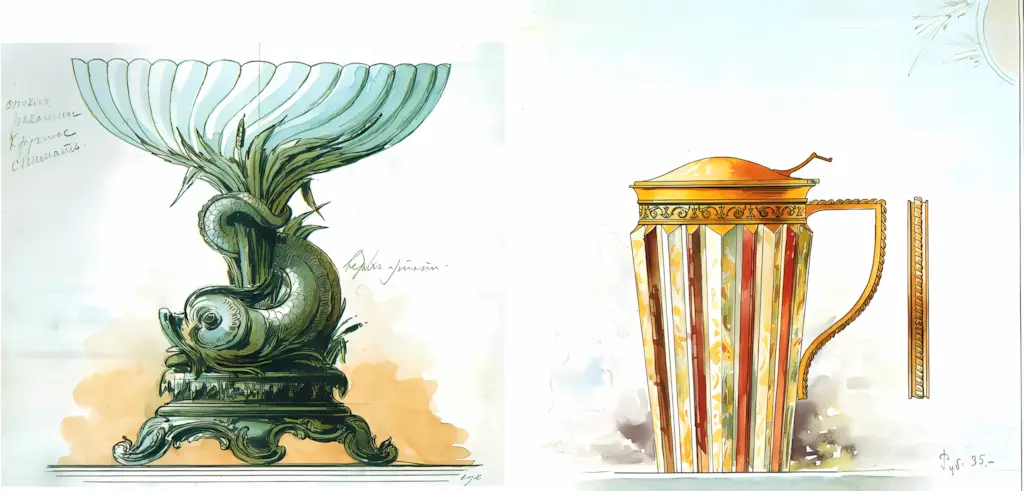
Интересно наблюдать обсуждения сотрудников компании о функциональности предметов, например, они размышляли, возможно ли сделать подсвечники разборными для удобства транспортировки. Есть надписи, касающиеся сроков выполнения заказов, что придаёт работам особую историческую значимость. Проект вазы из хрусталя и серебра с номером 32126 (вероятно, это инвентарный номер) и ценой 1 700 рублей продемонстрирован с пометкой: «уже продана». Таким образом, это уникальное собрание рисунков является своего рода хрониками творчества фабрики Фаберже, служащими важным документальным источником о работе московского филиала с конца 1890-х годов и до начала 20-х годов XX века.
«А всё Кузнецкий мост, и вечные французы...». С этой строки словно начинается новая глава в расследовании утраченных шедевров ювелирного искусства, где каждый штрих, каждый эскиз вновь открывают перед нами великолепие и сложность художественного наследия. Эти находки, взаимодействующие с наследием Фаберже, наполняют пространство между прошлым и настоящим, чтобы напомнить о культуре и искусстве, которые сформировали не только российское, но и мировое наследие. Когда мы рассматриваем эти шедевры, мы как будто становимся участниками вековой истории, успевшей запечатлеть в себе дыхание времени, стремление к идеалу и необходимость иметь память о своем прошлом. Культурное и художественное наследие, оставленное мастерами, становится источником вдохновения для будущих поколений, формируя новый взгляд на драгоценное искусство, погружая нас в бесконечный мир креативности и инноваций.
Несмотря на то что миллиарды людей во всем мире уже никогда не смогут увидеть штамп «К. Фаберже Москва» на большом числе эскизов, предполагается, что большинство из них произошло именно от филиала, находившегося в сердце российской столицы. Многочисленные аналоги, хранящиеся как в государственных, так и в частных коллекциях, подтверждают это, а также фотографии готовых изделий московского отделения, гордо украшающие прейскуранты 1893 и 1899 годов.
Филиал в Москве был основан в 1887 году известным ювелиром Петером Карлом Фаберже при поддержке его компаньона Аллана Бо, который, будучи подданным Великобритании, долгое время управлял московскими делами. Карл Фаберже, в свою очередь, оставался основным владельцем и проживал в Санкт-Петербурге, в то время как Бо руководил всей деятельностью своего филиала: он вёл учёт, оформлял контракты, занимался соблюдением законов и привлекал рабочих. После его отставки в 1906 году управление перешло к Отто Ярке, а позже к сыну основателя, Александру Фаберже, высококвалифицированному художнику, геммологу и искусствоведу. В 1912 году, после совместных усилий Ярке и Александра, было инициировано открытие нового торгового дома под именем «Александр Фаберже». Однако неудача в переговорах после смерти Ярке оставила московский филиал в рамках имени Карла Фаберже.
Магазин и мастерская ювелиров располагались в живописном районе на Кузнецком мосту, который по праву считали одной из самых престижных улиц столицы. Именно здесь, среди сверкающих витрин, соблазнительных изысканных украшений и обручальных колец, можно было ощутить роскошь и стать частью элегантной жизни. Улица мгновенно привлекала внимание обеспеченной публики, ведь она уже тогда получила название «бриллиантовой»: украшения из серебра и золота, сверкающие драгоценными камнями, манили покупателей издалека. Неизменно шли потоки людей мимо ювелирных магазинов, где предложения от таких известных поставщиков, как Иван Хлебников и Павел Овчинников, соседствовали с шедеврами от выдающихся ювелиров семьи Болин и Павла Буре.
Среди них магазин Фаберже занимал особое место. Расположенный в шикарном здании на углу Кузнецкого и Неглинной, он привлекал клиентов своими непередаваемыми по красоте творениями: от изобилия ювелирных украшений до высокохудожественной галантереи. Магазин стал символом утонченности и мастерства, в котором соединялись инновации и безупречная техника изготовления.
Каждый день это место заполнялось светом и жизнью, а рядом проходили мимо продвинутые горожане, готовые потратить на искушение исполинские суммы. Здесь изготавливались не просто изделия, а настоящие произведения искусства, олицетворяющие лучшие традиции русского ювелирного мастерства. Каждый ювелир компании создавал изделие с душой, оттачивая каждую деталь, чтобы передать дух времени и элегантность культуры, которой владела империя.
В эти годы Кузнецкий мост стал не только символом роскоши, но и важнейшим культурным центром, где смешивались таланты, идеи и вкус, оставляя в памяти столетий неизгладимый след.
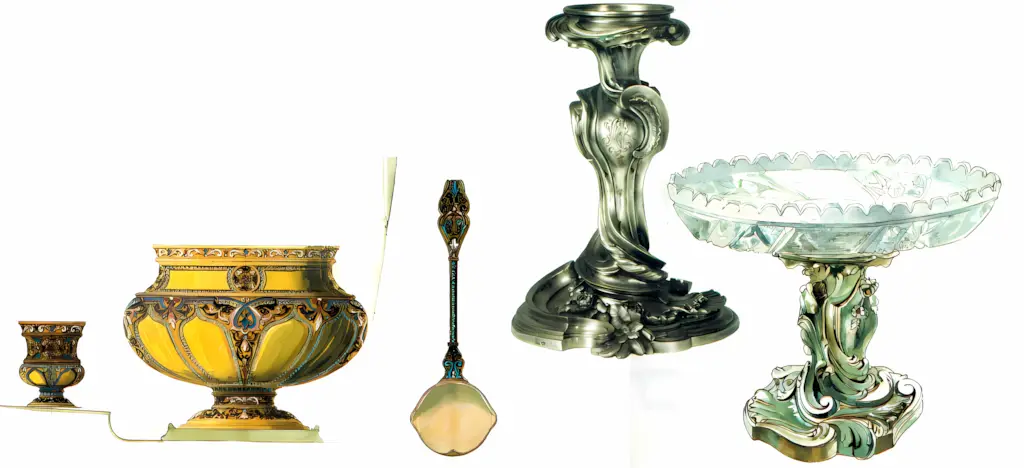
К моменту открытия московского филиала в 1887 году на исторических просторах столицы уже активно функционировали ювелирные компании, среди которых Овчинников, Хлебников, Немиров-Колодкин и семьи Болин. Тем не менее, Фаберже сумел завоевать симпатии публики всех социальных слоев. Успех фирмы во многом объяснялся способностью её сотрудников учитывать запросы как высшего света, так и представителей среднего класса. Они не ограничивались лишь производством изысканных и дорогих изделий, но также стремились предложить более доступные по цене украшения для менее обеспеченных клиентов. В московском магазине каждый мог найти что-то по душе и по карману — от потрясающей бриллиантовой ривьеры до скромной брошки из золота стоимостью три рубля, украшенной полтиной.
Фаберже был известен своей честностью в ценообразовании. Компания всегда гарантировала, что ее расценки — это самые справедливые, а стоимость изделий соответствуют затраченным усилиям и качеству используемых материалов. Это правило стало одним из трех основополагающих принципов, которые фирма неуклонно соблюдала на протяжении всей своей истории. Первый прейскурант появился в 1893 году как ответ на возрастающий интерес со стороны провинциальной публики, жаждущей приобрести изделия от Фаберже. Эти уникальные каталоги стали настоящим окном в мир ювелирного искусства, демонстрируя разнообразие предметов из золота и серебра, хотя в них сознако не были представлены «лучшие фасоны», чтобы обезопасить себя от конкурентов, которые могли бы попытаться скопировать шедевры.
Постепенно Фаберже начал привлекать внимание не только московских модников, но и зарубежных клиентов. Открытие новых филиалов за границей способствовало расширению клиентской базы и формированию доверительного отношения к бренду. Процветание Фаберже стало не только результатом мастерства, но и умения наладить качественный сервис. Клиенты, попадая в магазин, могли быть уверены, что они получат не просто товар, но и уникальный опыт обслуживания, который дарил ощущение значимости и эксклюзивности.
Большое внимание уделялось и дизайну магазина. Фирменная атмосфера создавала ощущение аристократической изысканности, а уставленные витрины предлагали изумительные ювелирные изделия, которые сверкали алмазами и были дополнены сложной эмалью и драгоценными камнями. Каждый элемент интерьера, каждая деталь были продуманы до мелочей, создавая атмосферу, где полноценное наслаждение искусством шло рука об руку с практичным выбором.
Фаберже привнес не только мастерство в производство ювелирных изделий, но и душу в каждое из своих творений. Каждое изделие, выходящее из мастерских компании, становилось произведением искусства, которое поднимало стандарты ювелирного дела. Высококвалифицированные мастеровые, работающие под руководством выдающихся ювелиров, стали олицетворением русского художественного ювелирного мастерства, синтезируя лучшие традиции и современные идеи.
Клиенты оставались верными Фаберже не только за качество продукции, но и за чувство сопричастности к чему-то большему — миру, где каждый ювелирный акцент воплощал дух времени. Фаберже не просто продавал изделия; он создавал художественный контекст, в который вписывались имперские традиции и богатый культурный фон. И благодаря этому, среди ювелирных компаний, фирма Фаберже быстро заняла ведущее место, оставаясь в памяти не только москвичей, но всех, кто стремился к великолепию и утонченности в каждом аспектe своей жизни.
Покупатели, переступая порог магазина Фаберже, могли быть уверены, что им предложат только самые актуальные и элитные образцы ювелирного искусства. Выпуск товарных коллекций «новейших фасонов» стал вторым краеугольным камнем успеха предприятия. В московском филиале работали одаренные мастера-дизайнеры, воспитанники императорского Строгановского училища и Центрального училища технического рисования имени барона Штиглица. Среди них выделялись такие имена, как С.Н. Андрианов, И.И. Либерг — главный художник серебряного отдела, и Е. И. Шишкина-Голиневич. Также стояли братья Н.А. и К.А. Клодт фон Юргенсбург, знающие толк в орнаментике, и М.П. Иванов, который на протяжении нескольких лет трудился художником-композитором на московском заводе.
Московская фабрика не ограничивалась созданием массовых изделий, а с удовольствием бралась за выполнение индивидуальных заказов заможной знати, именитых музыкантов и актеров, а также представителей императорского дома, таких как великая княгиня Елизавета Фёдоровна, вдова генерал-губернатора Сергея Александровича, и знаменитая балерина Екатерина Гельцер. На протяжении своего существования магазин обеспечивал своих клиентов не просто изделиями, но уникальными шедеврами, позволяя каждому из них создать свой собственный стиль.

Покупатели могли спокойно объяснить заказчику свои пожелания, ведь службу в бутике возглавлял специальный приказчик. Он доводил детали до каждого художника, влияя на конечный продукт. Важнейшими аспектами обсуждения были цена, используемые материалы, а также сам дизайн будущего произведения — покупатель мог выбрать из нескольких эскизов наиболее понравивший.
Примечательно, что товары, утраченные во времени или вышедшие из моды, долго не задерживались на витринах на Кузнецком мосту. Они собирались и один раз в год переплавлялись, что позволяло поддерживать ассортимент в актуальном состоянии и избавить магазин от лишнего товара. Даже изделия, стоимость которых не превышала одного рубля, создавались с максимальной тщательностью и надежностью, так как фирма никогда не использовала недоброкачественные материалы. Именно благодаря этому внимание к качеству, бренд Фаберже стал одним из наиболее посещаемых и уважаемых в старинной столице. Продукция московского филиала быстро завоевала симпатии не только потребителей в России, но и пользователей за пределами страны.
Московская мастерская Фаберже, расположенная в Большом Кисельном переулке, достигла пика своей продуктивности около 1890 года и на рубеже веков стала крупнейшим ювелирным предприятием в Российской империи. Здесь трудились около трехсот специалистов, что значительно превышало количество мастеров в Петербурге, где работали около ста мастеров различных профессий. Несмотря на то что Карл Фаберже подчеркивал высокое качество петербургских изделий и строгий художественный контроль, именно московская фабрика обеспечивала основной доход компании. В ней производилось множество товаров, доступных для гораздо более широкой аудитории.
На предприятии функционировали четыре основные секции: ювелирная, серебряная, механическая и гранитная. По словам Франца Петровича Бирбаума, главного листера фирмы, серебряное производство в Москве обладало высокими художественными достоинствами и образцовой организацией. Бирбаум в своих мемуарах отмечал, что серебряное дело в столице превосходило по масштабам и качеству петербургское, и к началу XX века все крупные изделия из серебра изготавливались именно в московской мастерской.
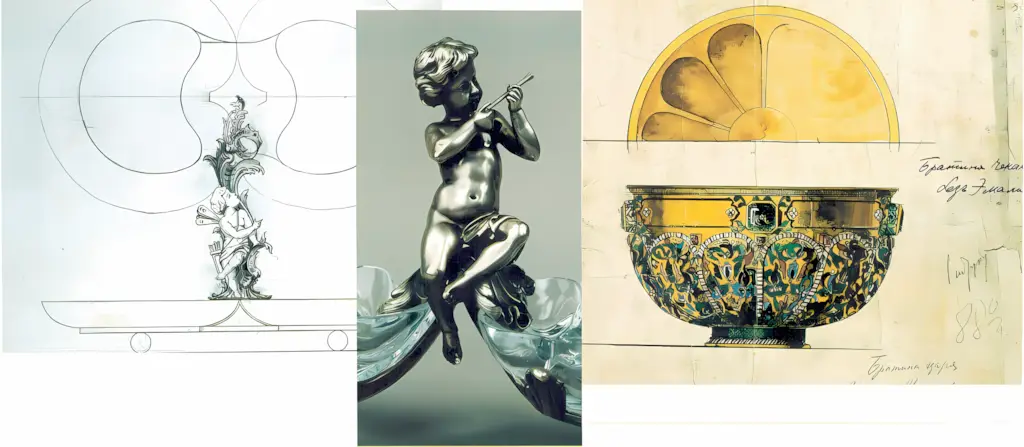
Специализация московского филиала позволила не только поддерживать высокие стандарты качества, но и эффективно реагировать на запросы клиентов. В отличие от петербургской мастерской, где строгая структура и традиции накладывали ограничения, московская работа имела большую гибкость, что позволяло адаптироваться под потребности разнообразных заказчиков. Высококачественные изделия производились здесь не только для императорского двора, но и для состоятельных граждан, желавших украсить свои жизни уникальными ювелирными изделиями.
Работающие в московском филиале мастера использовали самые современные технологии и изготавливались уникальные предметы, которые оставили свой след в истории русского ювелирного искусства. Благодаря этому Фаберже смогли развить бесподобный стиль, который сочетал в себе традиционные русские мотивы и западавшие тенденции, создавая таким образом оригинальные и востребованные изделия.
Многочисленные выставки, проводимые на московской фабрике, ярко демонстрировали высококлассное мастерство художников и ювелиров, работающих в ней. На этих выставках появлялись не только традиционные украшения, но и удивительные механизмы, которые поражали воображение публики своими сложными механизмами и утонченным дизайном. Эти изделия не только привлекали внимание высшего общества, но и завоевывали симпатии молодой буржуазии, которая с удовольствием приобщалась к искусству и моде.
К началу XX века московская фабрика Фаберже окончательно утвердила свои позиции на российском рынке и вышла на международные сцену. Изделия данной мастерской стали символом изысканности и вкуса, что подтолкнуло к развитию новых торговых связей с европейскими контрагентами. Каждый новый проект, появлявшийся на свет, служил подтверждением самодостаточности и уникальности русской ювелирной традиции, не забывая при этом о высоких стандартах, установленных предшественниками.
Одним из знаковых моментов в истории московской фабрики стал рост числа индивидуальных заказов от представителей императорского двора и знати, что только укрепило репутацию компании. Повышенный интерес к уникальным изделиям, к примеру, оптовые закупки для царской семьи, способствовали расширению производства и внедрению новых технологий обработки драгоценных материалов. Каждое произведение, созданное мастерами, становилось не только моментом эстетического наслаждения, но и свидетельством их таланта и преданности искусству.
При этом фирма Овчинникова и другие известные ювелирные дома создавали конкурентное поле, на котором Фаберже удавалось быть в авангарде. Участие в международных выставках и ярмарках позволяло демонстрировать достижения предприятия и притягивать внимание иностранных покупателей, что также способствовало общему росту популярности бренда Фаберже.
С каждым годом, продолжая создавать изделия, которые удивляли и восхищали, фирма Фаберже закладывала основу для будущих успехов. Каждый предмет, выходивший из московской мастерской, становился не просто ювелирным изделием, а объектом искусства, олицетворяющим дух времени и утончённый вкус. Таким образом, московская фабрика не только оставила заметный след в истории ювелирного искусства России, но и внесла важный вклад в мировую культурную сокровищницу, сделав старое новое, а забытое снова актуальным.
Сравнить эскизы ювелирных шедевров с фотографиями завершённых изделий из торговых прейскурантов — занятие, полное захватывающей эстетической игры. Каждый штрих на рисунке дышит духом времени, а готовый объект, собравший в себе технику и замысел мастеров, раскрывает таинственные нюансы их художественного языка. Как приятно видеть, что художественные идеи, незабываемо зафиксированные на бумаге, воплотились в жизнь.
Так, в прейскуранте 1893 года на странице 30 можно найти изображение графина для вина, выполненного из граня этого самого хрусталя, одетого в оксидированную чеканную отделку в стиле неорококо. Эта работа была изготовлена с такой точностью, что вплоть до рисунка алмазной грани можно усмотреть полное совпадение с проектом, как будто художник сам находился на грани величественного творения. Не уступает ему и графин из того же прейскуранта под номером 71, который отличается лишь еле заметными деталями, но все же радует глаз самобытностью рифлёной ручки выразительного силуэта и окантовки, которая завершает его образ.
В 1899 году прейскурант изобилует образцами, которые лишь подтверждают успехи мастерской. Один из них — крупный хрустальный кувшин, созданный для пива, воды, молока или кваса, которому придаёт утонченности украшение из серебряных листьев кувшинок. Однако в готовом исполнении кувшин лишился тонкого серебряного обода, запланированного изначально в дизайне. С этим изяществом контрастируют более сложные формы изделий, например, база для фруктов с хрустальной чашей, на постаменте в виде серебряного дельфина. Такой мотив находил отражение в трёх разных рисунках и был популярен среди вельмож. Проект вазы с дельфином, его стоимость доходила до 250 рублей, что соответствует цене в прейскуранте 1899 года, хотя, разумеется, изделия оказались не точными копиями оригинала.
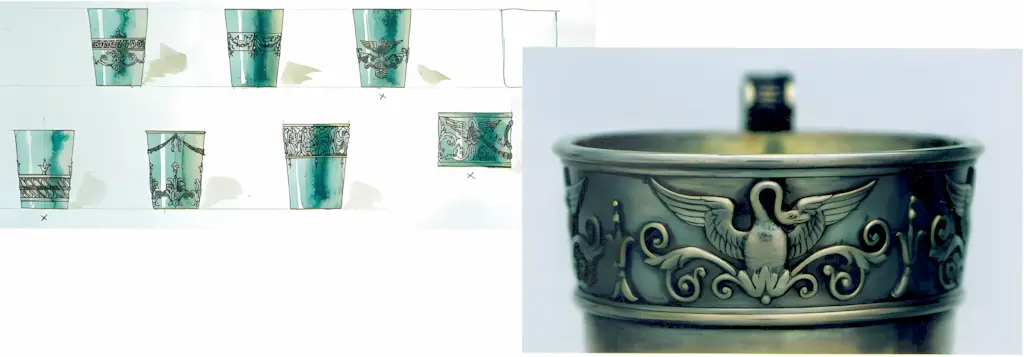
Несмотря на это, множество утилитарных предметов, упоминаемых в тех же прейскурантах, украшены детскими фигурами дельфинов, амуров или нимф, что придаёт изделием особый шарм и художественную выразительность. Составители этих каталогов регулярно подчеркивали наличие таких фигур как «чеканных деталей художественной работы», добавляя всем предметам дух великолепия и изысканности. Некоторые эскизы впечатляют великолепием своих скульптурных элементов. Первая из таких работ, находящаяся в частной коллекции, — ваза для варенья и конфет с фигуркой путто, играющего на свирели. Эта работа не только поразила красотой, но и стала полной копией проекта и фотографии из прейскуранта 1899 года, отмечая успех мастеров в искусном сочетании техники и эстетики.
Открывать страницы таких прейскурантов — это как путешествовать по времени, вдыхая аромат вечности. Каждое изделие, которое когда-то празднично контрастировало с металлическим блеском и сверканием драгоценных камней, теперь живёт уже за пределами своего первоначального предназначения. Каждый штрих и каждая выемка отзываются историей и мастерством, которое в своё время радовало глаз и подчеркивало статус.Iрина, ведь здесь каждая деталь сама рассказывает о вековых традициях, секретах ювелирного мастерства и культурных кодах, заложенных талантливыми руками.
Взглянем на замечательные подробности, касающиеся творений настоящих мастеров ювелирного искусства, которые стали символами своего времени. Примечания к различным эскизам и краткие описания, встречающиеся в прейскурантах, порой содержат жизненно важные сведения о материалах, технике исполнения и художественном стилевом направлении изделий. Например, ваза для фруктов, элегантно завершающаяся чеканной ножкой, украшенной завитками в рокайльном стиле и цветочными гирляндами, была выполнена «в стиле Людовика XV». Этот стиль, переживший свой ренессанс в 1880—1890-е годы, олицетворяет в себе всю изысканность и утонченность эпохи.
Сравните это с другим значимым аспектом: оба прейскуранта московской фабрики, изданные в 1890-х годах, свидетельствуют о царствовании стиля «третий рококо» в оформлении разнообразных серебряных предметов, от изящных ажурных оправ на кожаных бюварах до роскошных зеркал, изящно сделанных в климате чеканной работы. Имеется множество примеров великолепных произведений Фаберже, которые подтверждают популярность пышного стиля XVII века. В коллекции Музеев Московского Кремля хранится рокайльный серебряный постамент для вазы, который был создан на московской фабрике в период с 1899 по 1908 год и визуально напоминает аналогии из проектных чертежей.
Феноменальное сочетание эскизов, фотографий в прейскурантах и сохранившихся изделий позволяет нам более детально датировать эти рисунки. Преобладающее количество из них, вероятно, относится к раннему периоду существования московского филиала фабрики, заканчивающемуся в 1900 году. Углубив изучение крупного комплекса проектных работ, можно сделать интересный вывод о преобладании тех или иных видов предметов в московском серебряном производстве. Наиболее распространёнными стали графины и кувшины, число эскизов которых достигает 75. Неудивительно, что прейскуранты также акцентируют внимание на этих предметах. В дальнейшем следуют вазы для фруктов и цветов различных форм — от низких и округлых до вытянутых как горизонтально, так и вертикально на высоких ножках. Конечно, не останутся без упоминания чайники и чаяно-кофейные наборы, которые также стали важной частью производства.
Оценка значимости произведений искусства в сдержанном неоклассическом стиле, который стал выступать на сцену как новый тренд, также вносит ясность. Этот стиль пришел на смену лёгким формам рококо и представлен множеством изделий в духе Людовика XVI, ценимыми за строгие линии, строгость форм и утонченный декор. Начиная с XX века, элементы риска в дизайне стали встречаться реже: вместо грамматически сложных тяжелых постаментов с вытянутыми фигурами резвящихся амуров и нимф, дизайн ориентировался на полированные или матовые поверхности серебра, обогащенные антикизированным декором — пальметками, листьями аканта, гирляндами и жемчужными украшениями.
Работа дизайнеров фирмы Фаберже все чаще включала интерпретации стилистических средств известных французских мастеров Персье и Фонтена. Это можно заметить, например в рисунке кольца для салфетки или стаканчика, которые были выполнены «в духе Персье и Фонтена». В этом отношении фабрика демонстрировала не только приверженность к высоким стандартам качества и элегантности, но и способность адаптироваться к меняющимся вкусам публики, подтвердив прочную репутацию среди элитного круга и широкой аудиторией ценителей искусства.
Итак, благодаря изучению этих уникальных эскизов и сопоставлению их с уже готовыми изделиями, мы не только заглядываем в прошлое, наслаждаясь изысканностью каждого предмета, но и становимся посредниками в истории, где каждая деталь шепчет о времени, когда величие повседневного мужества и разнообразия формало изысканную ювелирную традицию.
Изучая произведения московской фабрики и элегантные проекты художников-композиторов, становится очевидным, что разговоры о различиях между петербургскими мастерскими Фаберже, которые неизменно ориентировались на классические стили, и московским филиалом, предполагаемо более настроенным на буржуазный и купеческий вкус, могут быть излишне упрощенными. Важно понимать, что хотя между этими двумя школами действительно были свои нюансы, московская продукция была тщательно адаптирована под запросы как местной, так и зарубежной клиентуры — включая петербургскую и лондонскую. Более того, значительная часть обуви шилась под руководством мастеров из Северной столицы и разрабатывалась по их эскизам.
Многочисленные рисунки, выполненные в неорусском стиле на рубеже XX века, прекрасно иллюстрируют данное утверждение. Например, проекты чаши с эмалью, ратины с ковшом-черпаком, датированные 1912 годом, и впечатляющая братина с шариковой ногой 1911 года — все они несут печать «К. Фаберже. СПб». Особенно примечателен рисунок братины с надписью «Царя Алексея Михайловича», решенной быть «чеканной, без эмали». На ум приходит роскошная золотая чаша, украшенная драгоценными камнями и врученная Алексею Михайловичу патриархом Никоном в 1653 году; сейчас она хранится в Оружейной палате Кремля. Однако, видно, что сотрудники фирмы не стремились создавать точную копию древнего артефакта, а намеревались внести свои оригинальные изменения. Уникальность Фаберже заключалась в том, что он никогда не слепо не подражал: отталкиваясь от старинных форм и декоров, он создавал новые, изысканные сочетания.
В начале века произошел переход к свободному, не имитационному подходу, что стало отражением новых веяний в прикладном искусстве. Мастера стремились не только перенять признаки прошедших эпох, но и привнести собственные идеи, находя вдохновение в традициях, но адаптируя их к современным требованиям и вкусам. Таким образом, ювелирные изделия, рожденные в стенах московской фабрики, отличаются самобытностью и неподражаемым стилем.
Примечательно и то, что многие изделия, подобные упомянутым, создавались с акцентом на высокое качество исполнения и уникальность, что подчеркивало престиж как самого продукта, так и его источника. Каждое творение Фаберже представляет собой не просто изделие, а целый комплекс идей, традиций и стилей, вразрез с простым копированием, выходя за рамки обыденного. Объекты искусства этого времени стали важными свидетелями изменений, произошедших в обществе, способствуя расширению горизонтов и популяризации ювелирного мастерства в России и за её пределами.
Анализируя эскизы, можно отметить, что многие из них не только обогащают знание о том времени, но и создают связь между прошлым и настоящим, заставляя зрителя задуматься о контексте, в котором они были созданы. Каждое деталь, каждая линия несут в себе отпечаток времени, как бы создавая диалог между мастером и будущими поколениями. Всё это превращает эскизы в своеобразный исторический источник, обогащающий нашу эпоху, позволяя постигать, как глубоко укоренены русские ювелирные традиции и как они формировали восприятие прекрасного на протяжении веков.
Создавая свои изделия, ювелиры фирмы Фаберже искали не простое копирование древнерусского стиля, а стремились к его вдохновению, чтобы передать очарование «старинного сказочного прошлого». Именно в Москве был реализован наибольший объем таких работ. По словам Ф.П. Бирбаума, главной отличительной чертой московских изделий от петербургских стал акцент на русском народном стиле. К числу наиболее ярких произведений этого направления относились братины, жбаны, ковши, ларцы и художественные вазы. Сюжетами для них служили мотивы из народных былин и сказок, а также исторические события, которые вполне могли быть изображены как в виде отдельных фигур, так и групповых сцен, выполненных в виде барельефов непосредственно на предметах. Чаще всего эти изделия создавали с помощью восковой отливки, и в большинстве случаев они существовали в единственном экземпляре.
Тематика богатырев вдохновения проходит через четыре эскиза и две фотографии из описываемого собрания; два проекта отображают царскую охоту, изображая, соответственно, псаря и сокольничего. «Бояромания», распространенная в обществе в связи с юбилеем династии Романовых в 1913 году, нашла свое отражение в эскизе братины с красочным эмалевым панно, созданным в технике «en plein air». Сувенирные ковши, братины и чаши часто становились призами и подарками ко всякого рода юбилеям и памятным событиям. Поскольку эти предметы в основном не использовались для практических нужд, акцент полностью смещался на их декоративные особенности. Мастера позволяли себе смело проявлять фантазию, нередко экспериментируя с размерами изделий. Они могли как значительно увеличивать, так и уменьшать соотношения, преображая и изменяя формы традиционных сосудов и разрабатывая необычные орнаменты, которые представляли собой смешение ручных промыслов, древнерусского «узорочья» и интересных наблюдений за природой.
Ф.П. Бирбаум подчеркивал, что, несмотря на несоответствия и архаичность в исполнении, порой складывающееся впечатление шаблонности, все эти недостатки перекрывались свежестью идей и отсутствием стандартных решений в композициях.
Творчество Фаберже было прямым отражением популярных «культурных запросов» своего времени. Проявляя гибкость в соответствии с капризами моды и потребностями клиентов, изделия могли быть исполнены как в строгом классическом стиле, так и в причудливом рокайле или национальном романтизме. Разнообразие технических приемов — от артистического скульптурного литья и традиционной русской скани до лаконичных штампованных узоров — также способствовало этому многообразию. Современный исследователь К. Сноуман однажды охарактеризовал Фаберже как «культурную губку», впитывающую все новые веяния и тренды. Вновь открытые комплексы художественных проектов этой легендарной фирмы дают возможность по-настоящему оценить широту ассортимента, разнообразие актуальных форм и орнаментов, а также смелые эксперименты, проводимые художниками. Они служат своего рода графической мини-летописью, свидетельствующей о творческом процессе Карла Фаберже.
